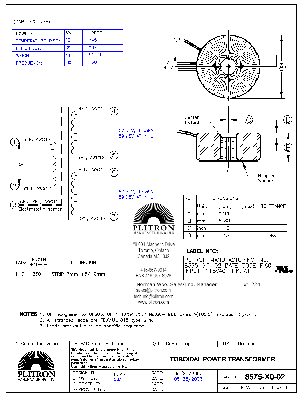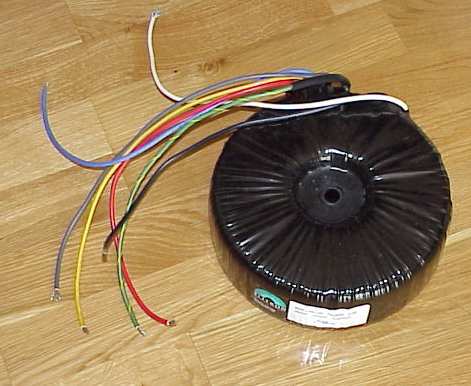|
|||||||
|
Introduction Of all the items in a home theater or audio system, there is really only one category that affects every component, namely Power Conditioners. AC power is noisy, because everyone in the neighborhood is on the same circuit and the AC lines act like antennae. It is also unbalanced in North America, and this means that the hot leg of the 120 Volt AC measured against ground might be 120 Volts, but the neutral leg measured against ground might be 2 Volts. This is due to the fact that the neutral leg is attached to ground back at the circuit breaker box, but is not at zero potential by the time you get to the AC wall socket. The neutral is the return leg for the current, and because it has some resistance, the voltage is not zero. With hi-fi
equipment, electrical noise manifests itself as audible noise in the
speakers. Obviously, this is undesirable. One way of reducing noise is by
using an isolation transformer that has the same output voltage at the
secondary as in the primary. The transformer acts as a band-pass filter,
which will not only block DC voltages (many components operate less
effectively in the presence of DC), but block high frequency noise (the
transformer coils act as an RF choke). Secondly, if the transformer provides
balanced AC out (+ 60 Volts on one leg and - 60 Volts on the other leg), any
noise that is picked up by components' power cords and extension cords is
cancelled through common mode rejection (CMR).
This happens when the balanced legs are combined to produce 120 Volts. Because the noise is the same
polarity on each leg, but the voltage is inverted on one with respect to the
other, the noise gets cancelled out between the two AC voltages. Also, a
benefit with balanced power is that you are then placing the The Transformer Design So, it is apparent that some benefit can be gained by isolating hi-fi equipment from noisy AC lines and converting the AC to a balanced supply. We have had many questions about such power conditioning, and in fact, we at Secrets are just as concerned about clean balanced AC as you are. I commissioned Plitron, a Canadian transformer manufacturer that is world renown for quality, to build an isolation transformer for the Secrets staff that would deliver balanced AC output. I wanted it to be rated at 2,000 watts and have an electrostatic shield for the input and output ground connections (electrical code requires that the ground be passed through from input to output for safety reasons). This electrostatic ground shield is situated between the primary and secondary windings. The secondary would be split into two separate windings so that we could have a center tap for connection to the ground. It had to be rated at 115 Volts AC in, and a little more than 115 Volts AC out, 60 Hz. The load should bring the voltage back down. Plitron accommodated us and came up with the following design. Click on the photo below to see the full size version of the diagram where you can read all the specifications. It is 2,000 VA, 60 Hz, weighs about 28 pounds, and does everything we want it to do, namely, it isolates the AC and delivers balanced output. It is a big transformer. Our staff is buying between 1 and 3 units each. Here is a photo of the transformer. It is about 9 inches in diameter.
Plitron makes transformers like this for many companies, but is not a supplier to consumers. In this case, they designed the transformer for Secrets. Our staff is buying and using this transformer. Normally, Secrets could market the unit and make a profit, like other companies do, but that is not what we are in business for. Plitron has expressed a willingness to sell the transformer to anyone who wants to buy it as part of the Secrets readership. So, in other words, you can get this 2,000 watt transformer at a wholesale price ($250), just as we do. It is a very special deal. Since Plitron gives better prices when the number of units sold goes up, if you want to buy the transformer, post your needs in the Secrets Group Purchase Forum and buy them as a group. There is a specific discussion about this transformer here. The phone number and contact person are listed on the diagram shown above. The unit is identified from the diagram as # 8575-X0-02. There are some components out there that don't like balanced AC, and even a few that may have internal connections of the neutral and ground wires. Suitability of balanced AC for your components is something you must determine for yourself in your own situation. Wiring It Note: Be very careful when working around electrical components. You are responsible for your own safety. If you are not experienced with electrical wiring, this project may not be for you. Wiring the transformer is relatively simple. Looking at the diagram, the input is straightforward. Using an industrial grounded AC wall plug (the wires are thick), Wire 1 (BLK- black) goes to the hot, Wire 2 (WHT-white) goes to the neutral, and Wire 3 (GRN-YEL; green-yellow) goes to ground. For the output, connect Wire 5 (YEL-yellow) and Wire 6 (BLU-blue) together along with a lead from Wire 3 (GRN-YEL; green-yellow) to the ground terminal on an industrial grounded AC socket (a separate one obviously, NOT one in the wall that is already connected to AC). Connect Wire 4 (RED-red) to the hot terminal on the socket. Connect Wire 7 (GRY-gray) to the neutral terminal on the socket. The transformer should be in a metal chassis for fire safety, and depending on the chassis design, it may be necessary to pull the transformer wires through holes in the chassis before connecting them to plugs or sockets. A 20 amp fuse on the input hot wire is advisable. The Results Once the unit is wired, the output should be measured with an AC voltmeter, to make sure that you have + 60 Volts on each leg vs. ground. You can put several AC sockets in the chassis if you like, or just plug a 20 amp power strip into the transformer, and all of your equipment into the power strip. Disclaimer Note that any warranties for this transformer are supplied by Plitron. Secrets does not build or market this transformer, and does not make any money from sales of the transformer. Participating in building such a project exposes the participant to a serious risk of injury or death by electrocution, fire, or other hazards. Secrets makes no claims as to the safety, performance, or reliability of this transformer or its use. Anyone who obtains this transformer assumes all risk and liability for its use. If you are
interested in learning more about the power transformers offered by Plitron
Manufacturing, Inc. (“Plitron”) or in purchasing Plitron products, you may
click on this link to Plitron’s website.
You expressly acknowledge and agree that Secrets of Home Theater and High
Fidelity, and its parent company, Scientific Design and Information, Inc.,
have no control over Plitron or its website, and that this link is provided
solely as a convenience.
- John E. Johnson, Jr. -
|
|||||||





